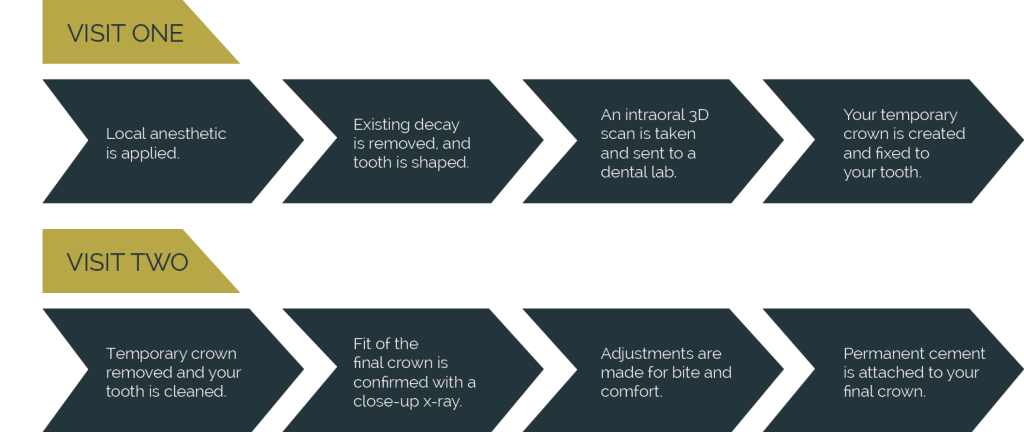Diamond Dental is now Stone Creek Dental. New name, same great team!
Diamond Dental is now Stone Creek Dental. New name, same great team!
A “dental crown” is a term familiar to most people, though some refer to it as a “cap.” There are actually two uses of the term crown in dentistry. We use the word crown to describe the anatomical portion of each tooth that protrudes out of the gums and bone. The crown of the tooth does not include the tooth’s roots, and in a healthy tooth, enamel covers the entire crown.
A bridge is a dental treatment that uses multiple crowns connected together in order to replace a missing tooth. At the minimum, a bridge includes two crowns on either side of a “fake” tooth called a pontic. Bridges are classified according to the number of units, which just means the number of teeth they cover. The most common is a three-unit bridge, which uses two teeth as anchors for one replacement tooth.
The materials of a bridge are the same as those available for crowns. Because a bridge uses connections between teeth, it requires some changes to your oral hygiene routine in order to keep the anchor teeth healthy. A bridge is a relatively quick way to replace a missing tooth, requiring only a few weeks of lab time. Bridges are permanently cemented onto the anchor teeth; they are not removable by the patient. A bridge is an alternative tooth replacement option to a dental implant.
A dental crown replaces the enamel covering of a tooth, and is needed when the enamel can no longer perform its function. Enamel is the hardest substance in the human body, designed to withstand the thermal, chemical and mechanical forces our teeth undergo when we eat and drink. Unfortunately, however, it is not invincible.
Enamel is susceptible to cracking, acid erosion, and decay from large cavities. Any of these reasons can lead to a weakened tooth. Patients who struggle with nighttime grinding or have had a root canal treatment may also be good candidates. A crown will then be recommended to protect your tooth from further damage.
In order to make a crown or bridge that fits perfectly, your dentist first prepares the tooth itself. Preparation involves removal of the enamel layer so that the crown can replace it without making the restoration bulky or uncomfortable. We also remove any existing decay or filling material. Basically, we get down to healthy tooth structure and rebuild from there.
Enamel is the protective coating of a tooth, and without it, the tooth is sensitive to hot and cold. This is why a dental crown preparation typically requires local anesthetic (but it is not necessary when the tooth has a root canal treatment, because there is no longer a nerve inside to feel that discomfort). This is also why we must cover the tooth with a temporary crown for the time necessary to make the final crown. A temporary crown insulates the tooth from uncomfortable sensations and holds the space for the final crown.
In general, both crowns and bridges are a two-visit process, with the temporary phase in between the two visits.
Visit One:
A local anesthetic is applied to ensure your comfort.
We prepare the tooth for the crown by shaping the outer tooth structure and removing any existing decay or filling material.
Severely broken down portions of the tooth may need to be rebuilt. This will feel like getting a filling.
In our office, an intraoral 3D scan of the prepared tooth is captured to send an exact replica to the dental lab. No more gooey, uncomfortable impression molds!
We make a temporary crown that fills in the space and protects the tooth, then affix it to your tooth using temporary dental cement.
This is your temporary crown. Specific care instructions will be provided until we see you again.
Visit Two:
Local anesthetic is available upon request if the tooth is sensitive. It is not always required for this visit.
The temporary crown is removed and excess temporary cement is cleaned away.
We place the final crown on the tooth and confirm the correct fit with a close-up x-ray.
Any necessary adjustments will be made to the bite until your new crown feels perfectly comfortable.
We use a permanent dental cement to attach the crown to your tooth.

A dental crown or bridge is a significant investment made for the health of your mouth. Most dental crowns “last” (meaning they do not require any further dental work on the tooth) anywhere from five to fifteen years. The lifespan varies narrowly based on the material of the crown and widely based on patient care and maintenance.
In order to promote a long lifespan for your dental crown, you must fight cavities by performing great oral hygiene at home and seeing us consistently for professional teeth cleanings, check-ups, and topical fluoride treatments to help strengthen the teeth. This is true for promoting the lifespan of any dental work.
Another common factor in the lifespan of dental crowns or bridges is breakage from heavy forces. If you exhibit signs of clenching and/or grinding your teeth while you sleep, we will likely prescribe a protective mouthguard for you to wear at night.
For more information on dental crowns and bridges, read our blog on Dental Crowns: What They Are and Why We Need Them.

Our team has delivered outstanding dental care in Midwest City for over 40 years. We are committed to providing our community with safe, gentle, high-quality dental care.
Should you have any questions or concerns regarding your dental care, we are more than happy to discuss how you can achieve a beautiful and healthy smile.
As a top dentist in Midwest City, we have helped hundreds of families achieve their oral health goals and are eager to help you and your family do the same.
Stone Creek Dental © 2025 | All Rights Reserved